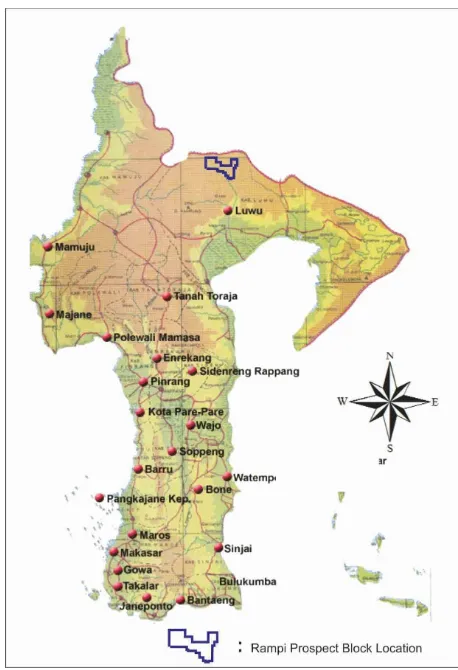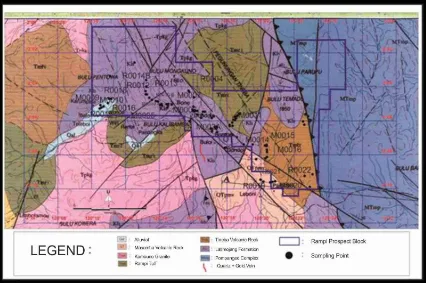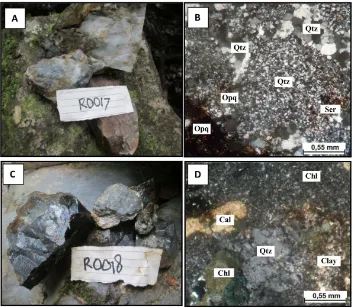Occurrences and Characteristics of Gold Mineralization in Rampi Block
Prospect, North Luwu Regency, South Sulawesi Province, Indonesia
Arifudin Idrus*1, Suaib Mansur2, Ahmad2, Rahmayuddin2, and Abdul Mahdi2
1Department of Geological Engineering, Faculty of Engineering, Gadjah Mada University, Indonesia 2Mining and Energy Agency, North Luwu District, South Sulawesi Province, Indonesia
ABSTRACT. This study is aimed to identify the occurences, characterisatics and genetic type of gold mineralization, and to elucidate the preliminary gold potential in the study area. Research method includes field observation of prospect geology, hydrothermal alter-ation and ore mineralizalter-ation. Laboratory analysis consists of petrography, ore microscopy and ore chemistry. Geologically, quartz ± gold veins were found in Rampi block prospect, which are mainly hosted by metamorphic and metasediment rocks. The quartz veins has structurally segmented with massive, brecciated and laminated textures. Orientation and distribution of veins is controlled by NW–SE and NE–SW trending structures. Sulfides are present with minor abundance (<1 %). Pyrite is obviously observed and partially oxidized. Arsenopyrite and stibnite are minor, while basemetal (Pb, Zn) sulfides are very rare. Gold mineralization occurred in quartz veins and closely related to silica-clay and silicic alter-ation. Gold grade varies from 0.1 to 11 ppm Au (29 samples). Quartz veins contained high gold grade (>9 ppm) commonly show laminated and brecciated texture and has been un-dergone a supergene enrichment. According to several characteristics above, gold deposit in Rampi block prospect tends to meet the criteria of orogenic/mesothermal gold type (cf. Groves et al., 2003). The deposit shares similarities with Awak Mas prospect, which is already confirmed to be a mesothermal type in Luwu district (cf. Querubin and Walters, 2011). Therefore, discoveries of economic mesothermal gold deposits are still open in the metamorphic terrains, and thus, it requires a systematic exploration based on the genetic model of the deposit.
Keywords: Gold · Orogenic/mesothermal · Rampi block prospect · North Luwu ·
Su-lawesi·Indonesia.
1 INTRODUCTION
The needs and metal prices, especially pre-cious metal and base metal in the world mar-ket are steadily increasing, “forcing” us to con-duct an inventory, exploration and extraction of those metal deposits. Moreover, with the implementation of regional autonomy and de-centralized management of mineral deposits, the exploration activities become vital in plan-ning and resource utilization policy to improve the regional economy. For example, North
*Corresponding author: A. IDRUS, Department of Geological Engineering, Faculty of Engineering, Gadjah Mada University. Jl. Grafika 2 Yogyakarta, Indonesia. E-mail: [email protected]
support-Figure 1: Research area (Rampi block prospect) in Rampi sub-district, North Luwu regency located in northern part of South Sulawesi province.
ing information for exploration activities and development of ore mineral resources in the re-gion.
2 REGIONALGEOLOGY
Rampi block prospect area is a plateau that ex-tends from east to west. The highest peak of the mountain in the area is Temaduri Mountain (2,074 m). Among these mountains, lies rivers which commonly flow to Lariang River and To-boru River. Regional stratigraphy of research area refers to the Geological Map of Malili sheet (Simandjuntaket al., 1991) (Figure 2). Region-ally, Rampi area is occupied by various litholo-gies from oldest to youngest including Pom-pangeo Complex (MTmp), Latimojong (Kls), Kambuno Granite (Tpkg), Rampi Tuff Forma-tion (Tmrt), Tineba Volcanic Rock (Tmtv) and Alluvium (Qal).
Pompangeo metamorphic rock complex (MTmp) is the oldest formation in the study
ite (Tpkg) consists of granite and granodiorite. Based on its lithological similarity with gran-ite in Pasangkayu map sheet, the Kambuno granite is estimated to be formed at 3.35 mil-lion years ago (Pliocene). Rampi tuff formation (Tmrt) is composed of tuffaceous sandstone, grey tuff and crystal tuff. This Formation is unconformably deposited on Latimojong For-mation and inter fingering with Tineba Volcanic Rock (Tmtv). Tineba Rock Volcanic consists of hornblende andesite lava, basalt, quartz latitte and breccia. This formation occupies Tineba plateau that extends northward Rampi area in northwestern part of Malili geological map. Al-luvium (Qal) is composed of river, swamp and coastal deposits.
3 RESEARCH METHODS
Figure 2: Regional geological map of Rampi block prospect area with 25.000 Ha plotted on Geolog-ical map of Malili, Majene, and western part of Palopo sheet (Simandjuntaket al, 1991). Sampling points and quartz veins are indicated on the map.
4 RESULTS ANDDISCUSSION
Geology of the study area
On the basis of regional geology and ge-ological observation, the studied area is predominantly occupied by sedimentary rock/metasedimentary rocks from Latimojong formation (Kls), and a wide variety of volcanic rocks including tuffs, breccias and andesite lava from Rampi tuff formation (Tmrt) and Tineba volcanic rock formation (Tmtv). Schists, gneiss, marble, serpentinite, meta- quartzite, phyllite and slate, members of the Pompangeo com-plex (MTmp) are exposed in the eastern part of the research area. Gold mineralization and base metals are found in the form of quartz veins hosted by metamorphic/sedimentary rocks/metasedimentary rock (Latimojong for-mation), volcanic rocks (tuff) and also possi-bly hosted in the Pompangeo metamorphic complex. Geological structures particularly NW–SE, NE–SW trending strike slip faults were interpreted to be a part of major Palu-Koro fault orders. The strike-slip faults were probably the main geological aspect
control-ling the formation of gold mineralization in the research area.
Hydrothermal alteration
Hydrothermal alteration types developed in re-search area consist of propylitic alteration (chlo-rite - epidote - calcite), argillic alteration (clay mineral) and silicification zone (quartz - clay). Field Observation indicates that ore mineraliza-tion in form of gold-bearing quartz veins are mostly enveloped by sillification and argillic zone. However, in some cases, quartz veins can be associated with propylitic alteration. In gen-eral, prophyllitic zone developed in the periph-ery of the mineralization system. Outcrop and petrographic microphotograph of silicified and propylitic altered rocks are seen in Figure 3.
Characteristics of gold mineralization
Figure 3: Outcrop/handspecimen and petrographic microphotograph of altered wall rocks in Rampi block prospect: (A) and (B) silicified rock; (C) and (D) propylitic altered rock.
silicified altered wallrock. Several quartz veins are hosted by prophyllitic altered rock. Quartz veins found in small scale mining at Tomonongka River and Salman Tunnel show typical characteristics of strongly brecciated, remnant texture of host rock is not observable due to pervasive alteration, chalcedonic quartz, fine grained, granular shape and minor cavi-ties filled by pyrite. Some quartz veins have beeen brecciated where chalcedonic quartz as fragment and clay mineral as matrix. They are commonly oxidized (limonitization) indicating a supergen enrichment process. Strong oxi-dized brecciated and laminated quartz veins contain high grade of gold. For instance, brec-ciated and limonitized quartz vein (Figure 4C) contains 11 ppm Au, low base metal content, 959 ppm Ag, 95 ppm As and 270 ppm Sb. Laminated quartz vein (Figure 4D) contains 10 ppm Au, low basemetal (Cu, PB, Zn), 125 ppm Ag, 80 ppm As and 75 ppm Sb. Generally, the sulfide abundance are minor (<1 %), pyrite is partially converted to hematite. Arsenopyrite and stibnite may be present in minor portion in
form of very fine-grained, which is proven by a significant content of As and Sb in the vein.
Ore chemistry
Based on geochemical analysis of 21 samples of ore veins/rock, gold grade in quartz vein oc-curred in studied area varies between 0.01 ppm to 3.57 ppm. The highest gold grade (3.57 ppm Au) was detected in the Sample 062B, and in the Sample 060B (2.82 ppm Au), while Samples 052B, 053B, 061B, 063B, 064B, 065B, 070B, 074B and 074B has gold grade ranging from 0.53 to 0.71 ppm. Other samples contain gold between 0.01 ppm and 0.17 ppm or less. Highest copper (Cu) is 127.73 ppm contained by Sample 074B, and the highest grade of Pb and Zn reaching 150.70 ppm and 94.89 ppm, respectively is con-tained by Sample 056B (Table 1).
Table 1: AAS assay of gold and associated elements in quartz vein and mineralized rock samples from Rampi block prospect, North Luwu district, South Sulawesi (in ppm).
No. Sample Au Ag Sb As Hg Cu Zn Pb
1 052B 0.71 0.05 na na na 40.7 53.08 47.89
2 053B 0.71 0.06 na na na 10.6 51.83 36.6
3 054B 0.53 0.33 na na na 78.68 15.79 56.36
4 055B 0.08 0.12 na na na 68.93 14.07 44.3
5 056B 0.1 0.3 na na na 43.11 94.89 150.7
6 057B 0.04 0.1 na na na 11.41 38.85 50.91
7 058B 0.69 6.12 na na na 12.22 85.59 40.19
8 059B 17 0.06 na na na 63.73 61.77 35.51
9 060B 2.82 0.07 na na na 47.65 66.31 34.08
10 061B 0.71 0.06 na na na 9.36 33.22 40.02
11 062B 3.57 0.07 na na na 13.61 87.06 36.63
12 063B 0.7 0.06 na na na 37.38 53.56 46.15
13 064B 0.69 0.01 na na na 45.96 30.76 40.02
14 065B 0.7 0.21 na na na 39.94 22.43 34.01
15 066B 0.12 0.08 na na na 78.68 80.09 45.88
16 070B 0.7 0.01 na na na 14.17 46.9 39.98
17 071B 0.01 0.04 na na na 79.07 40.28 33.84
18 072B 0.01 0.01 na na na 7.93 21.7 53.2
19 073B 0.01 0.01 na na na 4.06 21.34 58.19
20 074B 0.7 0.06 na na na 127.73 43.73 47.24
21 370202 0.07 - 79 - - na na -
22 370204 1 - - 53 - na na 99
23 370205 0.29 - - - - na na -
24 370206 0.06 - - 72 - na na -
25 370208 10 125 75 80 - na na -
26 370215 2.08 25 64 160 - na na 89
27 370220 11 959 270 95 - na na -
28 370221 1.39 - 31 14 - na na 71
29 370222 9.98 84 97 56 19 na na 27
Figure 4: Types and textures of chalcedonic-quartz vein containing significant gold found in Rampi block prospect, North Luwu district: (A) Massive chalcedonic quartz vei, (B) Brecciated quartz vein, (C) Brecciated and oxidized (limonitized) quartz vein, and (D) Laminated chalcedonic quartz vein.
(10 ppm Au) and Sample 370222 (9.98 ppm Au). The lowest gold of 0.06 ppm is contained by Sample 370206. Interestingly, the highest Sb (270 ppm) is contained by Sample 370220, whereas the highest As is found from Sample 370215 (160 ppm). Hg content is only detected in Sample 370202 (19 ppm). Copper, Pb and Zn contents are relatively low, ranging be-tween 4 to 127 ppm Cu, 27–150 ppm Pb, and 14.7–94.9 ppm Zn, respectively. Generally, gold mineralization at Salman tunnel is character-ized by silica-clay altered and weakly oxidcharacter-ized rock/zone of chalcedonic quartz (as fragment) and clay minerals (as matrix). Gold (Au) tends to be intimately associated with Sb, As and Hg, not to basemetals such as Cu, Pb and Zn. Gold content is relatively high and typically varies from 0.01 to 11 ppm. In addition, high gold content is also hosted by strongly oxidized quartz veins, which may suggest the important role of supergene enrichment processes.
Discussion: Mineralization style and gold po-tential
Currently, in Indonesia gold is mostly mined from volcanic-hosted hydrothermal deposit
types including LS-epithermal type e.g. Pongkor in West Java (Warmada, 2003) and Gosowong in Halmahera Island, skarn type e.g. Erstberg, Kucing Liar and Deep Ore Zone (DOZ) in Papua, and porphyry type e.g. Batu Hijau in Sumbawa Island (Idrus et al., 2007; Imai & Ohno, 2005) and Grasberg in Papua. In Sulawesi Island, gold mineralization is also predominantly related to volcanic rocks, which are extended along western and northern Neo-gene magmatic arcs of the island (Idrus, 2009). As outlined above, however, gold prospects have also been recognized in Rampi block prospect, North Luwu district, South Sulawesi province. Gold mineralization in Rampi block prospect is in form of quartz±gold veins are mainly hosted by metamorphic/metasediment rocks of Latimojong formation and Pompangeo metamorphic rock complex.
present in very fine-grained size. Rare sul-fide was also observed in gold-bearing quartz veins in Bombana, Southeast Sulawesi (Idrus & Prihatmoko, 2011), Gunung Butak, Buru Island (Idrus et al., 2014) and Awak Mas in Luwu (Querubin & Walters, 2011; Harjanto
et al., 2015). Gold grade in quartz veins are very erratic, with the highest gold grade is 11 ppm with elevated grade of As and Sb are 270 and 160 ppm, respectively. Basemetal (Cu, Pb, Zn) content in the quartz vein is relatively low compared to those in typical LS-epithermal gold-bearing quartz vein. Based on some ge-netic characteristics described above, gold-bearing quartz vein in the prospect area tends to meet the criteria of mesothermal (orogenic) gold type, which may be plotted into epizonal-mesozonal of orogenic continuum models (cf. Groves et al., 2003). The discovery of gold-bearing quartz veins (lode gold) contained significant gold grade hosted by metasedi-ment/metamorphic rocks in studied area, as well as the lesson learned from discovery of the nearest confirmed orogenic (mesotermal) gold prospect in Awak Mas, Luwu district (Queru-bin & Walters, 2011; Harjanto et al., 2015), it implies that the potential and opportunities to discover economic gold deposits in this re-gion is very open. This absolutely needs a systematic exploration activity by considering efficient, effective and cost-benefit principles.
5 CONCLUDINGREMARKS
Chalcedonic gold-bearing quartz veins dis-covered in several locations within Rampi block prospect are hosted by metamorphic rocks, meta-sedimentary rocks and sedimen-tary rocks mainly of Latimojong formation and Pompangeo metamorphic complex. The quartz veins are generally segmented struc-ture with typically massive, brecciated and laminated/banded textures. No open space filling textures of quartz veins were observed. Orientation and distribution of veins is con-trolled by NW–SE and NE–SW trending trans-compressional structures that might regionally be interpreted to be a part of major Palu-Koro fault orders. The strike-slip faults were proba-bly the main geological aspect controlling gold mineralization in the research area.
Ore mineralization is characterized by rare
sulfides (<1%), but fine-grained pyrite was observed and partly has been oxidized to hematite. Other sulfides such as arsenopyrite and stibnite may also be present in very fine-grained size. Basemetal sulfides including very fine-grained chalcopyrite, galena and spha-lerite are present in very minor. Hydrothermal alteration is characterized by the presence of silica-clay, silicification and propylitic type. Ore mineralization is closely associated with silica-clay and silicic alteration.
Ore chemical analysis of 29 selected miner-alized quartz veins indicates that gold greatly varies (erratic) ranging between 0.1 and 11 ppm Au. Gold-bearing quartz veins contained el-evated gold of more than 9 ppm Au are gen-erally characterized by laminated/banded and brecciated textures and has partially been ox-idized/limonitized (Fe-rich sulfides converted to hematite/goethite). Gold grade may be up-graded through supergene enrichment process. On the basis of those studied genetic characteristics, quartz veins/lode gold/reef discovered in Rampi block prospect tends to meet the criteria orogenic/mesothermal gold type (cf. Groves et al., 2003). Oro-genic/mesothermal gold in this area is con-trolled by NW–SE and NE–SW trending strike-slip (trans-compressional) structures and typ-ically hosted by metasediment/metamorphic rocks of Latimojong formation. The same ge-ological framework also controlled the for-mation of the nearest confirmed mesothermal gold prospect i.e. Awak Mas in Luwu district (cf. Querubin & Walters, 2011; Harjanto et al., 2015). This suggests that the metamorphic rock-hosted lode gold is still open to discover in this region through a systematic exploration program.
ACKNOWLEDGEMENTS
Harjanto, E., Meyer, F.M., Idrus, A. (2015) Geology and Mineralization of Awak Mas Gold Deposit and Challenges for New Exploration Targeting in the Metamorphic Rock Terrain of Eastern Indone-sia, 13th SGA Meeting, Nancy, France, 24-27 Au-gust, 2015, p. 103-106.
Idrus, A., Kolb, J., Meyer, F.M. (2007) Chemical composition of rock-forming minerals in copper-gold-bearing tonalite porphyry intrusions at the Batu Hijau deposit, Sumbawa Island, Indone-sia: Implications for crystallisation conditions and fluorine-chlorine fugacity, Special Issue, Re-source Geology 57: 102-113.
Idrus, A., Warmada, I.W., Setyawan, I., Raditya, B., Kurnia, M. (2009) Endapan Urat Epitermal di Tir-tomoyo, Kabupaten Wonogiri, Propinsi Jawa Ten-gah: Studi Awal mengenai Alterasi Hidrotermal, Mineralisasi Bijih dan Inklusi Fluida. Majalah Ge-ologi Indonesia 24(1): 13-20.
Idrus, A., and Prihatmoko, S. (2011) The meta-morphic rock-hosted gold mineralization at Bom-bana, Southeast Sulawesi: A new exploration tar-get in Indonesia, Proceedings of The Sulawesi Mineral Seminar, Manado 28-29 November 2011, p. 243-258.
Idrus, A., Sufriadin, Nur, I. (2011) Hydrothermal Ore Mineralization in Sulawesi: A Point of View of Tectonic Setting and Metallogenesis, Proceed-ing JCM Makassar 2011, The 3th HAGI and 40th
Buru island, Indonesia. Indonesian Journal on Geoscience 1(1): 9-19.
Imai, A. and Nagai, Y. (2009) Fluid inclusion study and opaque mineral assemblage at the deep and shallow part of the Batu Hijau porphyry Cu-Au deposit, Sumbawa, Indonesia. Resource Geology, 59: 231-243.
Marshall, D., Anglin, C.D., Mumin, H. (2004) Ore Mineral Atlas, Geological Association of Canada, Mineral Deposits Division, St. Johns Newfound-land, 112 p.
Querubin, C.D., and Walters, S. (2011) Geology and Mineralization of Awak Mas: A Sedimentary Hosted Gold Deposit, South Sulawesi, Indone-sia, Proceedings of The Sulawesi Mineral Semi-nar, Manado 28-29 November 2011, p. 211-229. Simandjuntak, T.O., Rusmana, Surono, Supanjono
(1991) Peta Geologi Lembar Malili, Majene dan Palopo Bagian Barat, P3G Bandung.
Thomson, A.J.B., Thomson, J.F.H. (1998) Atlas of Al-teration, A Field and Petrographic Guide to Hy-drothermal Alteration Minerals, Geological Asso-ciation of Canada, Mineral Deposits Division, St. Johns Newfoundland, 119 p.




